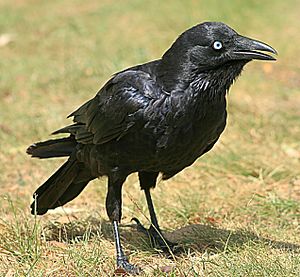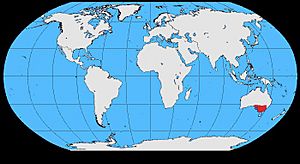Little raven facts for kids
Quick facts for kids Little raven |
|
|---|---|
 |
|
| Conservation status | |
| Scientific classification | |
| Genus: |
Corvus
|
| Species: |
mellori
|
 |
|
| Distribution map | |
The little raven (Corvus mellori) is a type of bird found in southeastern Australia. It belongs to the Corvidae family, which includes crows and jays. An adult little raven is about 48–50 cm (19–19.5 in) long. It has completely black feathers, a black beak, and black legs.
Like other Australian ravens, its black feathers have grey bases. The eyes of adult little ravens are white. This bird was first named by Gregory Mathews in 1912. However, it wasn't until 1967 that scientists agreed to call it a separate species from the Australian raven (C. coronoides).
Contents
Discovering the Little Raven
In the 1960s, a group called the CSIRO was studying Australian ravens. They were looking at how these birds affected sheep farming in southeastern Australia. During their research, they noticed a smaller type of raven living alongside the larger Australian raven.
These smaller birds preferred living in smaller trees. They also had smaller throat feathers and didn't have the bare skin that their larger relatives did. These birds also moved around a lot and made different sounds. A scientist named Ian Rowley looked into old scientific records. He found that these birds matched the description of Corvus mellori, which Gregory Mathews had described in 1912.
Raven Family Tree
The little raven is closely related to four other types of Australian corvids. These include the Torresian crow, little crow, forest raven, and Australian raven. Scientists have studied the genes of these birds to understand their family connections.
Early studies showed that the three raven species were related to each other. The two crow species were related to each other. Later, more detailed genetic studies showed that the forest raven and little raven are actually the closest relatives. The Australian raven is a bit further away on the family tree.
Scientists believe that the common ancestor of these five species came to Australia from the north. Then, it split into two main groups: crows that lived in tropical areas and ravens that lived in cooler areas. The ravens then split further as Australia's climate changed. This led to the different raven species we see today.
What the Little Raven Looks Like
The little raven is usually about 48–50 cm long. This makes it a bit smaller than the Australian raven, though their sizes can sometimes overlap. The little raven's beak is also slightly smaller.
Little ravens are more social than Australian ravens. They often form large groups that travel widely to find food. Their eye color changes as they grow:
- Baby birds (up to three months old) have blue-grey eyes.
- Young birds (three to eleven months old) have brown eyes.
- Older young birds (up to almost two years old) have hazel eyes with blue rings around the pupil.
How Little Ravens Call
The little raven makes a harsh, scratchy sound. It often sounds like "kar-kar-kar-karrr" or "ark-ark-ark-arrk". This call is similar to the calls of the Australian and forest ravens. Like most Australian ravens, the little raven sometimes slightly stretches or flicks its wings when it calls.
Like all birds in the corvid family, little ravens can copy sounds. This is mostly seen in birds kept by humans, but it happens rarely in the wild.
Where Little Ravens Live
The little raven lives across southeastern Australia. You can find them in southern South Australia, Victoria, and New South Wales. They also live on Kangaroo Island in South Australia and King Island in Bass Strait.
These birds live in many different places. They can be found in scrublands, farms, pastures, woodlands, treeless plains, along coasts, and even in suburbs. They are not found in west Gippsland, where forest ravens are more common.
The little raven is very common and its population is stable. Because of this, it is listed as a species of least concern on the IUCN Red List. This means it's not currently at risk of disappearing.
Little ravens have become more common in Melbourne since the 1980s. They have spread north and west, adapting well to city life. In contrast, Australian ravens are rarely seen in Melbourne's outer areas. However, in cities like Canberra and Sydney, the opposite is true. Australian ravens are common, while little ravens are not.
Little Raven Behaviour
Reproduction and Nests
Little ravens often build their nests in loose groups, sometimes with up to fifteen pairs nesting close together. Their nests can be just a few meters apart. This is because they only defend their nesting area, not their feeding grounds, which they share. They have even been seen nesting near Australian ravens. The Australian ravens don't seem to mind, probably because they eat different foods.
The nests are usually built low to the ground, often under 10 meters high. They are often placed in a forked branch at the edge of a tree's leafy part. Nests in cities like Melbourne are now being found higher up. This might be because they don't have to compete with Australian ravens as much in those areas. Sometimes, nests are even built on the ground.
Building a nest takes time. The birds first try to wedge sticks into a tree fork to make a platform. Then, they use thinner sticks and roots to create a bowl shape. Finally, they line the bowl with feathers. Both parent birds help build the nest. The female usually finishes the lining while the male brings her materials. They usually build new nests each year. This helps prevent the spread of diseases or parasites. Old nests also tend to fall apart within a year because they are out in the open.
A female little raven can lay up to six eggs, but usually lays four or five. Four eggs is the most common number. Raven eggs are light turquoise with brown spots. Crow eggs, however, are a dirty white with brown speckles. Young ravens leave the nest when they are about 33 to 41 days old.
What Little Ravens Eat
Little ravens eat more insects than Australian ravens. They mainly find their food on the ground. Like other Corvus species, they probably eat many different things when they get the chance. Some common insects they eat include spiders, millipedes, centipedes (which they chop the heads off before eating), grasshoppers, cicadas, and caterpillars. Caterpillars are especially important for feeding their young.
Little ravens are smart birds. They have been seen using tools and finding clever ways to get food.
See also
 In Spanish: Cuervo de Mellor para niños
In Spanish: Cuervo de Mellor para niños



